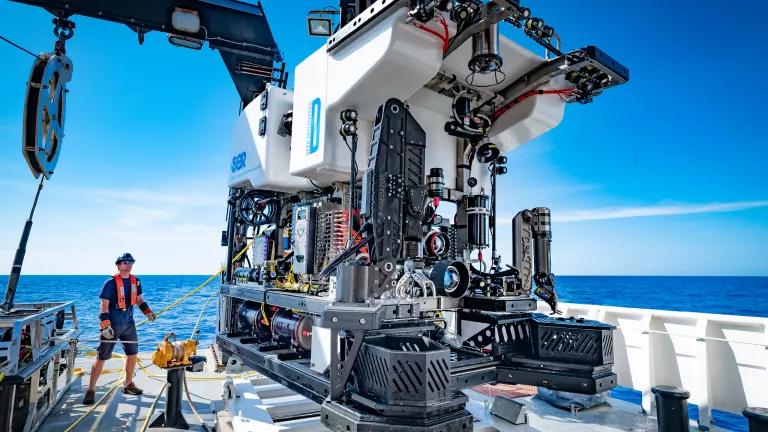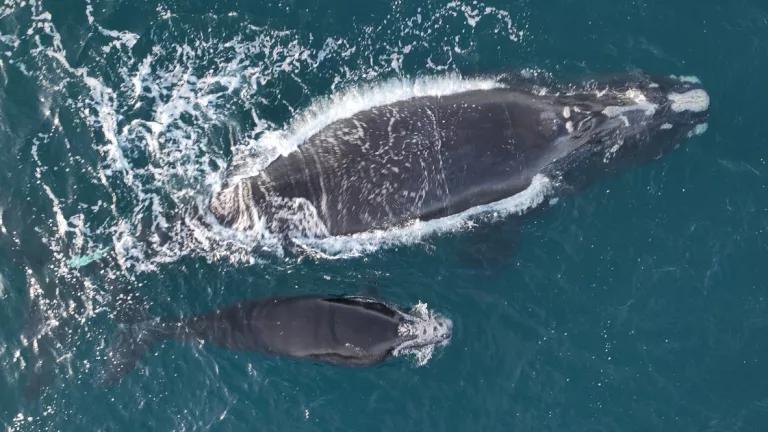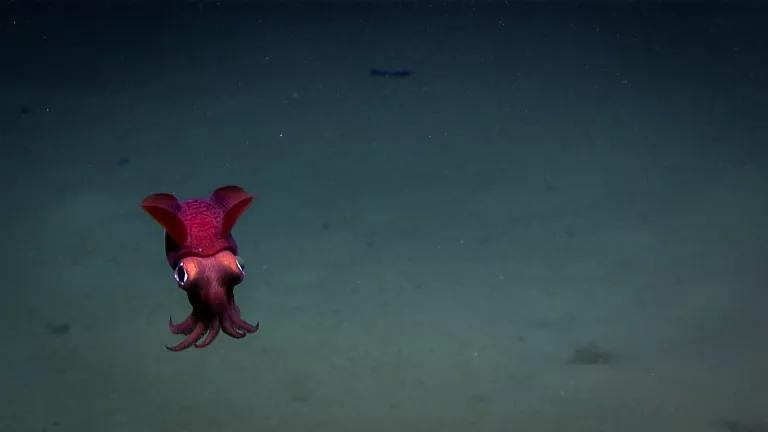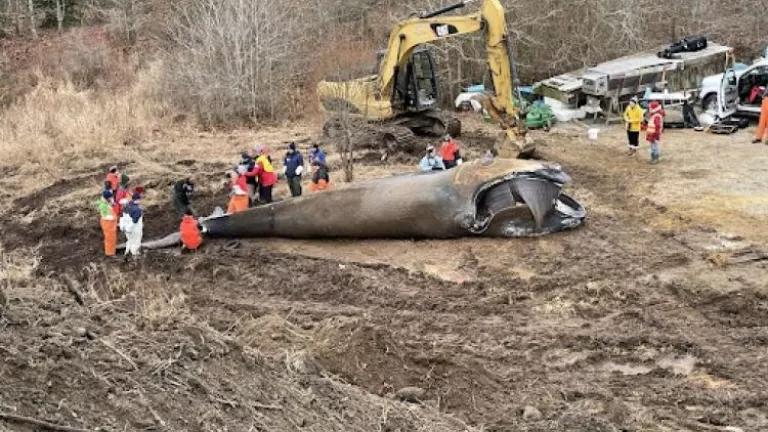Blake Plateau Mapping Q&A with Dr. Derek Sowers
Earlier this year, scientists, led by Dr. Derek Sowers, published a comprehensive map of the world’s most expansive cold-water coral mound province.

The remotely operated vehicle, Deep Discoverer, has been used to explore various parts of the Blake Plateau.
Art Howard, Global Foundation for Ocean Exploration, Windows to the Deep 2019
Dr. Sowers serves as the Mapping Operations Manager for the Ocean Exploration Trust and is based at the University of New Hampshire’s Center for Coastal and Ocean Mapping. He previously worked for NOAA Ocean Exploration for nine years as an Expedition Coordinator and Seafloor Mapper.
- Why is the Blake Plateau such a special place?
The Blake Plateau provides depths suitable to support certain species of reef-building cold-water corals and is bathed in the constant flow of the massive Gulf Stream current. Cold-water (deep-sea) corals grow in the dark and do not rely directly on sunlight like shallow water corals. These deep corals need a reliable supply of food particles sinking down through the water column to sustain them, and often currents to help deliver this food to them. This combination of conditions on the Blake Plateau has supported the development of the largest aggregations of cold-water coral mound and reef structures yet discovered on the planet.
The plateau’s nearly continuous coral mound features span an area of 6.4 million acres (an area larger than the state of Vermont), with a core area of very high-density mounds covering an area of 1.5 million acres (an area larger than Grand Canyon National Park). Our mapping analysis revealed 83,908 individual peak features, most of which are likely cold–water coral mounds.
- What makes the Blake Plateau’s sub-regions unique?
A striking feature of the cold-water coral reefs here is that different regions of the plateau have very different patterns of mound formation, densities of mounds, and the vertical relief of the mounds. For instance, the area nicknamed “Million Mounds” has by far the greatest density of mounds packed tightly together, while Richardson Reef has many long and tall linear reef chain features. Other areas have widely spaced small mounds that can form in organized wave-like patterns or, alternatively, in seemingly random distribution. Some mounds seem to have formed on top of underlying rock geological features, while others appear to have formed on softer substrates and built up their height solely from generation upon generation of coral skeletons and trapped sediments.
- Why are we only now learning about this spectacular coral habitat off the southeastern coast?
The simple fact is that only about half of underwater America has been mapped in any kind of detail so far. We are talking about a huge area extending from our coastlines out to 200 miles offshore – which is an ocean area roughly equivalent to the land area of America.
We just haven’t allocated the funding and dedicated time to map these areas with research ships until recently.
Fortunately, that is changing now that the US is investing in expeditions to explore our oceans – led in the deep sea by NOAA Ocean Exploration and other federal agencies, and partnering with academic, industry, and non-profit organizations such as the Ocean Exploration Trust. We are all working together on a national strategy to map, explore, and characterize underwater America.
It has been known since the 1960s that this area located roughly 100 miles offshore the coasts of Florida, Georgia and South Carolina had large deep-sea coral reefs. Since that time, extensive research has been conducted by regional experts to discover new mounds throughout the Blake Plateau and to document the ecological importance of these habitats.
NOAA was guided by scientists and managers working in this region to focus on mapping the entire extent of these reefs so that collectively we can better understand and protect this extraordinary marine ecosystem. The recently completed mapping effort in the region builds on the foundational work of the marine research community by revealing the full extent and characteristics of these important deep sea coral mound features.
- What technologies were used to map the Blake Plateau?
The mapping work on the Blake Plateau was completed by ships using multibeam sonar systems mounted on the hull of the vessels. This is the modern technology that enables seafloor mappers to create highly detailed bathymetric (underwater topographic) maps of the ocean. Mapping data from 31 different expeditions were used to compile the nearly complete map of the plateau.
Most of the recent mapping work was conducted under the auspices of the Atlantic Seafloor Partnership for Integrated Research and Exploration (ASPIRE) campaign between 2017 and 2019. NOAA Ocean Exploration and partners conducted 16 expeditions focused on collecting new mapping and imagery data to close large gaps throughout the southeast region. A separate but related key research initiative in the southeastern U.S. region was launched in 2017 called Deep-Sea Exploration to Advance Research on Corals/Canyons/Cold seeps (DEEP SEARCH) with funding from the National Oceanographic Partnership Program.

Geomorphic landform overview map with subregions labeled A–H: Jellyfish Mounds (A); Richardson Mounds (B); Streamlined Mounds (C); Ripple Mounds (D); Mini Mounds (E); Pinnacle Mounds (F); Sparse Mounds (G); and Million Mounds (H). All subregions contain CWC mound features. Black circles show the location of submersible dives with video footage of the seafloor used to ground-truth substrates. The yellow star on the inset map represents the location of the Blake Plateau adjacent to the southeast U.S. coastline. | Geomatics 2024
- What role do coral mounds play for our ocean?
These cold-water coral mounds – or reefs – play an important role recycling nutrients in the deep sea to support the surrounding ecosystem, sequestering carbon, and providing complex structure and hard substrate that provides habitat for many associated corals, sponges, invertebrates, and fishes. They are therefore essential in supporting biodiversity, ocean health, and recreational and commercial fisheries in the southeast U.S. and beyond.
- How high can the mounds grow?
The tallest mounds we mapped rise up to 171 m (561 ft) above the surrounding seafloor. The average mound height on the Blake Plateau is about 65 ft. The areas referred to as Stetson Banks and Richardson Reef have the tallest mound features and also often form linear chains of reef structures.
- How long have they been down there?
The answer probably depends on the specific area and how conditions have changed over time. However, dead coral samples from mound features on the Blake Plateau have thus far been dated between 5,000 and 44,000 years old.
- Some scientists call this a living laboratory - what types of information can scientists learn from the Blake Plateau?
These ecosystems are challenging to access and study, so we are just starting to understand them and the community of life they support. However, recent work demonstrates that while these corals depend on food particles from shallow water they also play an important role in effectively recycling nutrients back into surrounding waters and thus helping to sustain surface productivity. There are all sorts of natural products that come out of the marine environment that we’re looking at for anti-cancer drugs and antibiotics and other pharmaceutical advances. Corals here can also be studied to better understand impacts of climate change – such as warming and more acidic waters - on cold-water corals.
- What is your favorite deep-sea organism found on the Blake Plateau and why?
During one of the Alvin submarine dives to these coral reefs, a large swordfish was seen in this habitat. Hard to think of marine wildlife any cooler than a swordfish, so I am going with that as my current favorite.



